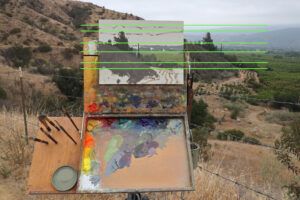The Sight-Size Method

The sight-size method doesn’t work with every scene (more on that below), but it’s a great help for placing shapes correctly. Here’s how it works.
1. Set up your easel so that your canvas is lined up horizontally with the view you’ve chosen to paint.
2. While sketching the scene on your canvas, make horizontal comparisons between the elements in the landscape and your sketch. (See example photo.)
3. Hold out your pencil or brush horizontally at arm’s length to help line things up.
Bonus Tip: This method can also be helpful for color matching. Since your painting and the actual landscape are visually right next to each other, you can more easily compare values and colors between the two.
When It Doesn’t Work
The sight-size method doesn’t work for every scene. You’ll have to choose a subject that’s an appropriate distance away. In other words, it may not work well for:
1. Close-up views
2. Scenes that are above or below your canvas (think tall-building cityscapes or deep canyons)
3. Subjects that move, such as ocean waves or cloudscapes
4. Situations when your canvas would have to be in direct sunlight in order to be next to your view (direct sunlight on your canvas while you paint can cause other problems, such as causing you to think the colors you’re painting are much lighter than they actually are)
But when you find a situation with an appropriate scene, give the sight-size method a try. For more inspiration, check out the work of artist Marc Dalessio. I’d say he has mastered the technique. His Instagram account shows lots of beautiful sight-size examples.
1. Set up your easel so that your canvas is lined up horizontally with the view you’ve chosen to paint.
2. While sketching the scene on your canvas, make horizontal comparisons between the elements in the landscape and your sketch. (See example photo.)
3. Hold out your pencil or brush horizontally at arm’s length to help line things up.
Bonus Tip: This method can also be helpful for color matching. Since your painting and the actual landscape are visually right next to each other, you can more easily compare values and colors between the two.
When It Doesn’t Work
The sight-size method doesn’t work for every scene. You’ll have to choose a subject that’s an appropriate distance away. In other words, it may not work well for:
1. Close-up views
2. Scenes that are above or below your canvas (think tall-building cityscapes or deep canyons)
3. Subjects that move, such as ocean waves or cloudscapes
4. Situations when your canvas would have to be in direct sunlight in order to be next to your view (direct sunlight on your canvas while you paint can cause other problems, such as causing you to think the colors you’re painting are much lighter than they actually are)
But when you find a situation with an appropriate scene, give the sight-size method a try. For more inspiration, check out the work of artist Marc Dalessio. I’d say he has mastered the technique. His Instagram account shows lots of beautiful sight-size examples.
